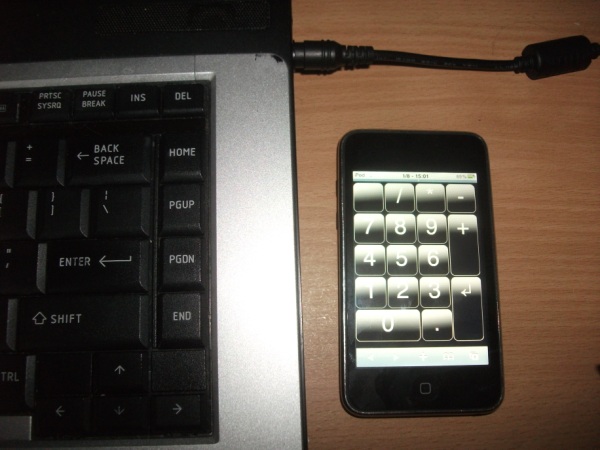iPhone as Numberpad
I made a simple HTML5 iPhone app that displays a numeric keypad.

My laptop doesn't have a numberpad, and I needed one for some of Blender's keyboard shortcuts. I was about to buy a USB numeric keypad, when I thought: If I call myself a programmer, I should
be able to make a numeric keypad. So I made one.
When you touch one of the keys, it POSTs the key to a
Sinatra
server on my laptop, where xdotool sends the X11 event
for the keypress to the active window.
There's no force feedback, so this wouldn't do for serious data entry. But for triggering simple keyboard shortcuts, this works perfectly.
Thoughts:
-
I'm really grateful someone wrote xdotool so I don't have to get my hands dirty with the X11 C++ API.
-
I love Sinatra. It's never been so easy to make a webapp, especially simple 'glue' applications like this one. It really is a superbly simple framework, and it gets right out of your way. The whole serverside code was less than 50
lines, most of which my validation of keycodes:
#!/usr/bin/env ruby
require 'rubygems'
require 'sinatra'
configure do
# make haml compile to html5
set :haml, :format => :html5
end
get '/' do
# compile views/index.haml
haml :index
end
post '/press/:key' do
# get the keycode for the numberpad key
keysym = keysyms[params[:key]]
# invoke xdotool to send the keypress to the active window
system("xdotool key #{keysym}") if keysym
end
# keycode reference is at /usr/include/X11/keysymdef.h
# all of these are keypad events, so they start with 'KP_'
keysyms = {
'zero' => 'KP_0',
'one' => 'KP_1',
'two' => 'KP_2',
'three' => 'KP_3',
'four' => 'KP_4',
'five' => 'KP_5',
'six' => 'KP_6',
'seven' => 'KP_7',
'eight' => 'KP_8',
'nine' => 'KP_9',
'multiply' => 'KP_Multiply',
'divide' => 'KP_Divide',
'add' => 'KP_Add',
'subtract' => 'KP_Subtract',
'decimal' => 'KP_Decimal',
'enter' => 'KP_Enter'
}
- Haml is excellent. It took 15 minutes to learn, and it made it so much faster to prototype new layout ideas. It was tricky to get the calculator aligned properly, but Haml made it easy to move bits of layout around, and change CSS classes:
!!! 5
%html
%head
%meta(charset='utf-8')
%meta(name='viewport' content='width=320; height=480; user-scalable=0;')
%title Numpad
%link(rel='stylesheet' href='/site.css' type='text/css' media='screen' title='default style sheet')
%body
#content
.row
.nothing
#divide /
#multiply *
#subtract -
.row
#seven 7
#eight 8
#nine 9
#add.tall +
.row
#four 4
#five 5
#six 6
.row
#one 1
#two 2
#three 3
#enter.tall ↵
.row
#zero.wide 0
#decimal .
%script(src='http://ajax.googleapis.com/ajax/libs/jquery/1.4.2/jquery.min.js')
%script(src='site.js')
Adding a class was a simple matter of adding a '.classname' to the element. Removing an element, I didn't have to find and remove its closing element - I just delete a line. The same goes for adding an element. It feels a lot nicer than HTML. I might redo this site in Haml sometime.
Try It
If you're on an X11 system, and have a phone with a browser, head over to the github page for installation instructions.

Comments ()